Glass Crusher Market
Glass Crusher Market Size and Share Forecast Outlook 2025 to 2035
Glass crusher market is projected to grow from USD 420.0 million in 2025 to USD 664.8 million by 2035, at a CAGR of 4.7%. Jaw/Impact will dominate with a 47.0% market share, while mrf/recycling plants will lead the end use segment with a 54.0% share.
Glass Crusher Market Forecast and Outlook 2025 to 2035
The global glass crusher market is valued at USD 420.0 million in 2025. It is slated to reach USD 660.0 million by 2035, recording an absolute increase of USD 240.0 million over the forecast period. This translates into a total growth of 57.1%, with the market forecast to expand at a CAGR of 4.7% between 2025 and 2035.
The overall market size is expected to grow by nearly 1.57 times during the same period, supported by increasing waste management regulations, growing environmental consciousness, expanding recycling infrastructure, and rising adoption of green waste processing solutions across various industrial and commercial applications.
Quick Stats for Glass Crusher Market
- Glass Crusher Market Value (2025): USD 420.0 million
- Glass Crusher Market Forecast Value (2035): USD 660.0 million
- Glass Crusher Market Forecast CAGR: 4.7%
- Leading Type in Glass Crusher Market: Jaw/Impact
- Key Growth Regions in Glass Crusher Market: North America, Europe, and Asia-Pacific
- Key Players in Glass Crusher Market: Andela Products, REM, PEL Waste Reduction, Krysteline, Glass to Sand, Komplet
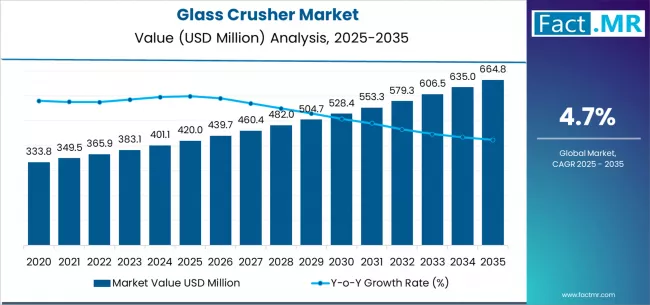
Between 2025 and 2030, the market is projected to expand from USD 420.0 million to USD 530.0 million, resulting in a value increase of USD 110.0 million, which represents 45.8% of the total forecast growth for the decade. This phase of development will be shaped by increasing regulatory enforcement for waste management, growing circular economy initiatives, and expanding recycling facility development. Equipment manufacturers and waste management companies are expanding their glass crushing capabilities to address the growing demand for efficient glass waste processing and recycling solutions.
Glass Crusher Market Key Takeaways
| Metric | Value |
|---|---|
| Estimated Value in (2025E) | USD 420.0 million |
| Forecast Value in (2035F) | USD 660.0 million |
| Forecast CAGR (2025 to 2035) | 4.7% |
From 2030 to 2035, the market is forecast to grow from USD 530.0 million to USD 660.0 million, adding another USD 130.0 million, which constitutes 54.2% of the overall ten-year expansion. This period is expected to be characterized by the expansion of smart waste processing technologies, development of energy-efficient crushing systems, and growth of integrated waste-to-resource solutions for glass recycling applications. The growing adoption of automated sorting systems and IoT-enabled monitoring will drive demand for glass crushers with enhanced automation and operational efficiency capabilities.
Between 2020 and 2025, the market experienced consistent growth, driven by increasing environmental regulations and growing recognition of glass crushers as essential equipment for waste volume reduction and recycling optimization. The market developed as waste management facilities and recycling centers recognized the potential for glass crushing technology to reduce transportation costs, improve storage efficiency, and support green waste management practices while maintaining operational cost effectiveness and environmental compliance.
Why is the Glass Crusher Market Growing?
Market expansion is being supported by the increasing focus on waste management optimization driven by environmental regulations and green initiatives, alongside the corresponding need for efficient glass processing solutions that can reduce waste volume, facilitate recycling processes, and minimize disposal costs across various waste management facilities and commercial establishments. Modern waste management companies and facility operators are increasingly focused on implementing glass crushing solutions that can optimize waste handling efficiency, reduce transportation requirements, and provide comprehensive waste volume reduction while maintaining operational cost effectiveness and environmental compliance.
The growing focus on circular economy principles and resource recovery is driving demand for glass crushers that can support comprehensive recycling processes, enable material recovery, and ensure green waste management through advanced crushing technologies and processing capabilities. Waste management operators' preference for equipment that combines operational efficiency with environmental benefits and cost optimization is creating opportunities for innovative glass crushing implementations. The rising influence of regulatory compliance and environmental responsibility is also contributing to increased adoption of glass crushers that can provide superior waste processing performance without compromising operational safety or environmental standards.
Segmental Analysis
What factors enable the jaw or impact type and MRF or recycling plants end-use segments to lead market growth and demand?
The market is segmented by type, end use, and mobility. By type, the market is divided into jaw/impact, hammer, and roll/others crushers. Based on end use, the market is categorized into MRF/recycling plants, hospitality, and industrial applications. By mobility, the market is segmented into stationary and portable equipment.
By Type, the Jaw/Impact Segment Leads the Market
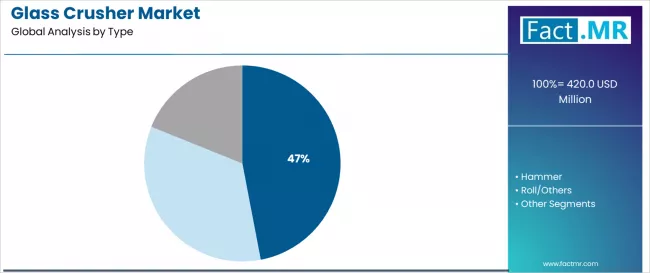
The jaw/impact segment is projected to maintain its leading position in the market in 2025 with a 47.0% market share, reaffirming its role as the preferred crushing technology for glass waste processing due to superior crushing efficiency and versatile application capabilities. Waste processing facilities and equipment operators increasingly utilize jaw and impact crushers for their effective glass breaking mechanisms, reliable operation characteristics, and proven effectiveness in handling diverse glass waste types while maintaining consistent output quality and operational reliability. Jaw/impact crusher technology's proven performance and operational versatility directly address industry requirements for efficient glass processing and consistent crushing results across diverse waste management applications and facility configurations.
This crusher type segment forms the foundation of modern glass waste processing, as it represents the technology with the greatest contribution to processing efficiency and established performance record across multiple facility types and operational scales. Waste management industry investments in jaw and impact crusher technologies continue to strengthen adoption among operators and facility managers. With operational requirements demanding efficiency and reliability, jaw/impact crushers align with both processing objectives and cost optimization requirements, making them the central component of comprehensive glass waste management strategies.
By End Use, the MRF/Recycling Plants Segment Dominates Market Demand
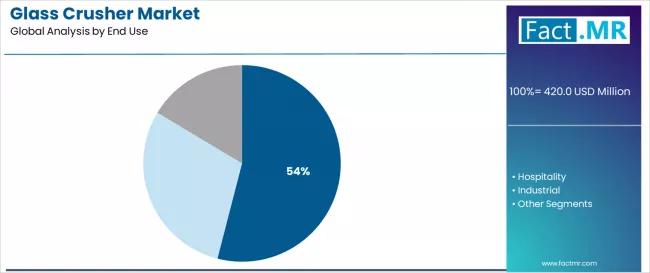
The MRF/recycling plants end-use segment is projected to represent the largest share of glass crusher demand in 2025 with a 54.0% market share, underscoring its critical role as the primary application for glass crushing equipment across material recovery facilities and specialized recycling operations. Facility operators prefer glass crushers for MRF applications due to their volume reduction capabilities, processing efficiency benefits, and proven effectiveness in optimizing recycling workflows while supporting comprehensive waste management and material recovery objectives. Positioned as essential equipment for recycling facilities, glass crushers offer both operational advantages and resource recovery benefits.
The segment is supported by continuous innovation in recycling technology and the growing availability of specialized crushing systems that enable superior glass processing with enhanced efficiency and automated operation capabilities. Recycling facility operators are investing in comprehensive processing equipment programs to support increasingly sophisticated recycling requirements and material recovery optimization demands. As recycling volumes increase and processing efficiency requirements advance, the MRF/recycling plants application will continue to dominate the market while supporting advanced waste management strategies and resource recovery optimization.
What are the Drivers, Restraints, and Key Trends of the Glass Crusher Market?
The glass crusher market is advancing steadily due to increasing waste management regulations driven by environmental protection requirements and sustainability mandates, alongside growing demand for waste volume reduction solutions that provide cost savings, operational efficiency, and environmental compliance across various waste management facilities and commercial applications. The market faces challenges, including high equipment investment costs for comprehensive systems, maintenance requirements for heavy-duty operation, and noise and dust control considerations for urban installations. Innovation in noise reduction technologies and automated operation systems continues to influence equipment adoption and installation optimization patterns.
Expansion of Regulatory Enforcement and Environmental Compliance
The growing enforcement of waste management regulations is driving demand for glass crushers that can ensure compliance with waste reduction mandates, support comprehensive recycling programs, and provide documented waste processing capabilities through advanced monitoring and reporting systems. Waste management facilities require sophisticated crushing equipment that delivers regulatory compliance across multiple environmental parameters while maintaining operational efficiency and cost effectiveness. Equipment manufacturers are increasingly recognizing the competitive advantages of compliance-focused crusher design for regulatory adherence and market acceptance, creating opportunities for specialized equipment designed for stringent environmental requirements and comprehensive waste management compliance.
Integration of Smart Technology and Automation Systems
Modern glass crusher manufacturers are incorporating smart technology and automation capabilities to enhance operational monitoring, enable remote control, and support comprehensive performance optimization through IoT connectivity and intelligent control systems. Leading companies are developing connected crushing systems, implementing predictive maintenance capabilities, and advancing automation technologies that optimize crushing performance while reducing manual intervention and operational complexity. These technologies improve operational efficiency while enabling new processing opportunities, including automated operation, remote monitoring, and data-driven performance optimization.
Development of Noise Reduction and Urban-Friendly Technologies
The expansion of urban waste processing requirements and noise regulation compliance is driving demand for quiet-operation glass crushers with advanced noise reduction technologies, vibration control systems, and urban installation compatibility that address neighborhood concerns and regulatory compliance requirements. These advanced systems require sophisticated engineering capabilities and acoustic control technologies that exceed traditional crushing equipment requirements, creating premium market segments with enhanced urban compatibility. Manufacturers are investing in noise reduction research and urban-friendly design to serve location-sensitive applications while supporting innovation in urban waste management and community-acceptable processing solutions.
Analysis of the Glass Crusher Market by Key Countries
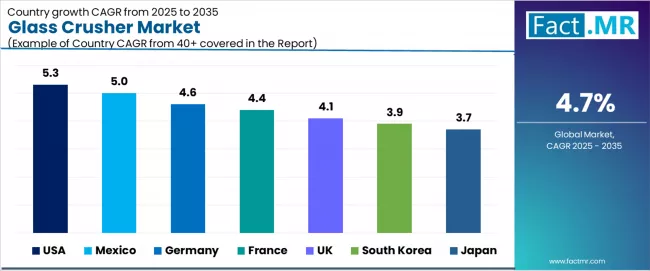
| Country | CAGR (2025-2035) |
|---|---|
| USA | 5.3% |
| Mexico | 5.0% |
| Germany | 4.6% |
| France | 4.4% |
| UK | 4.1% |
| South Korea | 3.9% |
| Japan | 3.7% |
The market is experiencing solid growth globally, with the USA leading at a 5.3% CAGR through 2035, driven by comprehensive waste management regulations, expanding recycling infrastructure, and growing environmental consciousness supporting equipment adoption. Mexico follows at 5.0%, supported by developing waste management systems, expanding recycling initiatives, and increasing industrial waste processing requirements. Germany shows growth at 4.6%, emphasizing circular economy principles, advanced waste management practices, and environmental compliance standards. France demonstrates 4.4% growth, supported by waste reduction mandates, recycling facility expansion, and sustainable waste management policies. The UK records 4.1%, focusing on waste diversion goals and recycling optimization. South Korea exhibits 3.9% growth, emphasizing waste management modernization and recycling infrastructure development. Japan shows 3.7% growth, supported by advanced waste management systems and resource recovery focus.
Why does the USA lead global market growth through a focus on regulatory compliance?

The USA is projected to exhibit exceptional growth with a CAGR of 5.3% through 2035, driven by comprehensive waste management regulations and rapidly expanding recycling infrastructure supporting equipment adoption among waste management companies, recycling facilities, and municipal operations. The country's environmental compliance requirements and growing sustainability consciousness are creating substantial demand for glass crushing solutions. Major equipment manufacturers and waste management companies are establishing comprehensive processing capabilities to serve both domestic markets and regulatory compliance requirements.
- Strong waste management regulations and environmental compliance requirements are driving demand for glass crushers throughout recycling facilities, waste management centers, and municipal operations across major metropolitan areas and industrial regions.
- Growing recycling infrastructure development and sustainability initiatives are supporting the rapid adoption of waste volume reduction technologies among facilities seeking operational efficiency and competitive advantages in waste management markets.
How does Mexico demonstrate strong market potential through infrastructure development?
Mexico is expanding at a CAGR of 5.0%, supported by the country's developing waste management systems, expanding recycling initiatives, and increasing focus on industrial waste processing and environmental compliance. The country's infrastructure development and growing environmental awareness are driving demand for efficient glass processing equipment throughout various waste management applications. Leading waste management companies and equipment suppliers are establishing comprehensive processing facilities to address growing domestic waste management requirements.
- Strong waste management system development and expanding recycling initiatives are creating opportunities for glass crusher adoption across municipal facilities, recycling centers, and industrial waste processing operations in major urban areas and industrial regions.
- Growing industrial waste processing requirements and environmental compliance focus are driving adoption of efficient crushing technologies among facilities seeking improved waste management capabilities and regulatory compliance assurance.
How does Germany demonstrate environmental excellence through a focus on the circular economy?
Germany is expanding at a CAGR of 4.6%, driven by the country's circular economy principles, advanced waste management practices, and comprehensive environmental compliance standards supporting sophisticated glass crushing equipment utilization. Germany's environmental leadership and waste management expertise are driving demand for premium crushing equipment solutions. Leading waste management companies and equipment manufacturers are establishing comprehensive innovation programs for advanced waste processing technologies.
- Advanced circular economy principles and environmental compliance standards are creating demand for sophisticated glass crushers among waste management facilities, recycling centers, and industrial operations seeking superior environmental performance and regulatory compliance.
- Strong waste management expertise and environmental leadership are supporting the adoption of premium crushing technologies across waste processing facilities, recycling operations, and specialized waste management applications throughout major industrial regions.
How does France focus on waste reduction and recycling optimization?
France is expanding at a CAGR of 4.4%, driven by the country's waste reduction mandates, recycling facility expansion, and comprehensive approach to green waste management supporting glass crusher integration into advanced waste processing applications. France's environmental policies and waste management culture are supporting investment in efficient crushing technologies. Major waste management companies and recycling facilities are establishing comprehensive processing development programs incorporating crushing equipment with French environmental expertise.
- Advanced waste reduction mandates and recycling facility expansion are creating demand for specialized glass crushers throughout waste management facilities, recycling centers, and environmental service providers serving sustainability-focused waste processing segments.
- Strong environmental policy focus and green waste management culture are driving the adoption of efficient crushing applications meeting French environmental standards and sophisticated waste processing requirements across diverse waste management applications.
How does the UK demonstrate market leadership through waste diversion goals?
The UK is expanding at a CAGR of 4.1%, supported by the country's waste diversion goals, recycling optimization initiatives, and growing focus on waste management efficiency supporting glass crusher adoption across waste processing applications. The UK's waste management targets and operational optimization trends are driving demand for efficient crushing solutions. Leading waste management companies and recycling facilities are investing in equipment modernization and processing efficiency improvements.
- Waste diversion goals and recycling optimization initiatives are creating opportunities for glass crushers throughout waste management facilities, recycling centers, and municipal operations serving efficiency-focused waste processing segments.
- Strong waste management targets and operational optimization are driving the adoption of efficient crushing systems across processing facilities seeking enhanced waste handling capabilities and operational excellence.
How does South Korea demonstrate modernization leadership through infrastructure development?
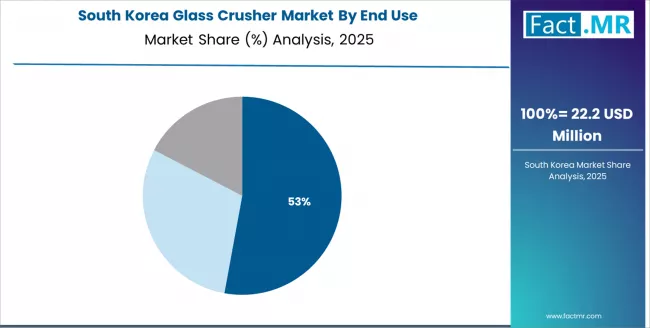
South Korea is expanding at a CAGR of 3.9%, supported by the country's waste management modernization initiatives, recycling infrastructure development, and growing focus on environmental compliance and operational efficiency supporting glass crushing equipment adoption. The nation's modernization capabilities and environmental consciousness are driving demand for advanced crushing solutions. Leading waste management companies are investing extensively in modern equipment and efficient processing technologies.
- Waste management modernization and recycling infrastructure development are creating demand for efficient glass crushers throughout waste processing facilities and recycling centers seeking technological advancement and operational efficiency.
- Strong environmental compliance focus and operational efficiency focus are supporting the adoption of modern crushing systems designed for advanced waste processing requirements and comprehensive environmental management across diverse applications.
How does Japan demonstrate a premium focus through advanced waste management?
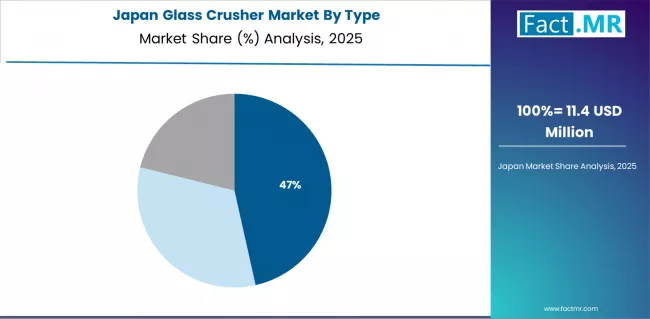
Japan is expanding at a CAGR of 3.7%, supported by the country's advanced waste management systems, resource recovery focus, and strong focus on efficiency and technological innovation supporting premium glass crushing equipment utilization. Japan's technological sophistication and environmental consciousness are driving demand for precision crushing equipment products. Leading waste management companies are investing in specialized capabilities for advanced waste processing applications and resource recovery optimization.
- Advanced waste management systems and resource recovery focus are creating opportunities for premium glass crushers throughout specialized waste processing facilities and high-efficiency recycling operations serving quality-critical processing applications.
- Strong efficiency focus and technological innovation are driving adoption of advanced crushing systems meeting Japanese waste management standards for excellence and technological sophistication across diverse waste processing applications.
Europe Market Split by Country
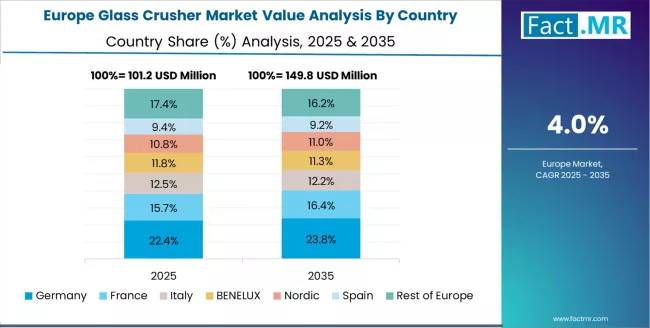
The glass crusher market in Europe is projected to grow from USD 120.0 million in 2025 to USD 185.0 million by 2035, registering a CAGR of 4.4% over the forecast period. Germany is expected to maintain leadership with a 33.3% market share in 2025, moderating to 33.1% by 2035, supported by circular economy principles, advanced waste management practices, and environmental compliance standards.
France follows with 27.3% in 2025, projected to reach 27.5% by 2035, driven by waste reduction mandates, recycling facility expansion, and green waste management policies. The United Kingdom holds 22.7% in 2025, expected to reach 22.8% by 2035 due to waste diversion goals and recycling optimization initiatives. Italy commands 10.0% in 2025, rising to 10.1% by 2035, while Spain accounts for 5.0% in 2025, reaching 5.1% by 2035. The Rest of Europe region is anticipated to hold 1.7% in 2025 and 1.4% by 2035, reflecting steady waste management equipment adoption in Nordic countries and emerging recycling infrastructure markets in Eastern European countries.
How is the competitive landscape of the glass crusher market structured and what key factors shape competition?
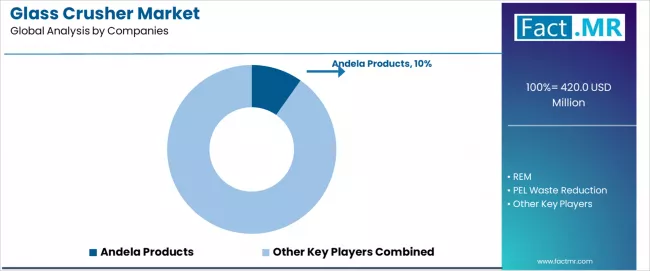
The market is characterized by competition among specialized waste processing equipment manufacturers, established crushing equipment companies, and innovative recycling technology providers. Companies are investing in noise reduction technology development, automation system integration, operational efficiency improvement, and comprehensive service capabilities to deliver high-performance, reliable, and environmentally friendly glass crushing solutions. Innovation in smart monitoring systems, automated operation capabilities, and eco-friendly processing technologies is central to strengthening market position and competitive advantage.
Andela Products leads the market with a 9.8% share, offering comprehensive glass crushing solutions with focus on hospitality applications, compact design optimization, and extensive customer support serving diverse commercial and institutional facilities. The company continues investing in noise reduction technologies and user-friendly operation systems while expanding product portfolio and market reach capabilities. REM provides specialized waste reduction equipment with focus on recycling applications. PEL Waste Reduction focuses on portable crushing solutions and waste management services. Krysteline specializes in glass-to-sand conversion technologies. Glass to Sand offers innovative glass processing solutions with environmental focus. Komplet emphasizes mobile crushing equipment and versatile applications.
Key Players in the Glass Crusher Market
- Andela Products
- REM
- PEL Waste Reduction
- Krysteline
- Glass to Sand
- Komplet
- WasteCare
- Stedman
- GGR Technologies
- QCR Recycling
Scope of the Report
| Items | Values |
|---|---|
| Quantitative Units (2025) | USD 420.0 million |
| Type | Jaw/Impact, Hammer, Roll/Others |
| End Use | MRF/Recycling Plants, Hospitality, Industrial |
| Mobility | Stationary, Portable |
| Regions Covered | North America, Europe, Asia-Pacific, Latin America, Middle East & Africa |
| Countries Covered | USA, Mexico, Germany, France, UK, Japan, South Korea, and 40+ countries |
| Key Companies Profiled | Andela Products, REM, PEL Waste Reduction, Krysteline, Glass to Sand, Komplet |
| Additional Attributes | Dollar sales by type and end use, regional demand trends, competitive landscape, technological advancements in crushing technology, noise reduction development, automation integration, and environmental compliance optimization |
Glass Crusher Market by Segments
-
Type :
- Jaw/Impact
- Hammer
- Roll/Others
-
End Use :
- MRF/Recycling Plants
- Hospitality
- Industrial
-
Mobility :
- Stationary
- Portable
-
Region :
-
North America
- United States
- Canada
- Mexico
-
Europe
- Germany
- United Kingdom
- France
- Italy
- Spain
- Netherlands
- Rest of Europe
-
Asia-Pacific
- Japan
- South Korea
- China
- India
- Australia
- Rest of Asia-Pacific
-
Latin America
- Brazil
- Argentina
- Rest of Latin America
-
Middle East & Africa
- Kingdom of Saudi Arabia
- South Africa
- Rest of Middle East & Africa
-
Table of Content
- Executive Summary
- Global Market Outlook
- Demand to side Trends
- Supply to side Trends
- Technology Roadmap Analysis
- Analysis and Recommendations
- Market Overview
- Market Coverage / Taxonomy
- Market Definition / Scope / Limitations
- Market Background
- Market Dynamics
- Drivers
- Restraints
- Opportunity
- Trends
- Scenario Forecast
- Demand in Optimistic Scenario
- Demand in Likely Scenario
- Demand in Conservative Scenario
- Opportunity Map Analysis
- Product Life Cycle Analysis
- Supply Chain Analysis
- Investment Feasibility Matrix
- Value Chain Analysis
- PESTLE and Porter’s Analysis
- Regulatory Landscape
- Regional Parent Market Outlook
- Production and Consumption Statistics
- Import and Export Statistics
- Market Dynamics
- Global Market Analysis 2020 to 2024 and Forecast, 2025 to 2035
- Historical Market Size Value (USD Million) Analysis, 2020 to 2024
- Current and Future Market Size Value (USD Million) Projections, 2025 to 2035
- Y to o to Y Growth Trend Analysis
- Absolute $ Opportunity Analysis
- Global Market Pricing Analysis 2020 to 2024 and Forecast 2025 to 2035
- Global Market Analysis 2020 to 2024 and Forecast 2025 to 2035, By Type
- Introduction / Key Findings
- Historical Market Size Value (USD Million) Analysis By Type, 2020 to 2024
- Current and Future Market Size Value (USD Million) Analysis and Forecast By Type, 2025 to 2035
- Jaw/Impact
- Hammer
- Roll/Others
- Y to o to Y Growth Trend Analysis By Type, 2020 to 2024
- Absolute $ Opportunity Analysis By Type, 2025 to 2035
- Global Market Analysis 2020 to 2024 and Forecast 2025 to 2035, By End Use
- Introduction / Key Findings
- Historical Market Size Value (USD Million) Analysis By End Use, 2020 to 2024
- Current and Future Market Size Value (USD Million) Analysis and Forecast By End Use, 2025 to 2035
- MRF/Recycling Plants
- Hospitality
- Industrial
- Y to o to Y Growth Trend Analysis By End Use, 2020 to 2024
- Absolute $ Opportunity Analysis By End Use, 2025 to 2035
- Global Market Analysis 2020 to 2024 and Forecast 2025 to 2035, By Region
- Introduction
- Historical Market Size Value (USD Million) Analysis By Region, 2020 to 2024
- Current Market Size Value (USD Million) Analysis and Forecast By Region, 2025 to 2035
- North America
- Latin America
- Western Europe
- Eastern Europe
- East Asia
- South Asia and Pacific
- Middle East & Africa
- Market Attractiveness Analysis By Region
- North America Market Analysis 2020 to 2024 and Forecast 2025 to 2035, By Country
- Historical Market Size Value (USD Million) Trend Analysis By Market Taxonomy, 2020 to 2024
- Market Size Value (USD Million) Forecast By Market Taxonomy, 2025 to 2035
- By Country
- USA
- Canada
- Mexico
- By Type
- By End Use
- By Country
- Market Attractiveness Analysis
- By Country
- By Type
- By End Use
- Key Takeaways
- Latin America Market Analysis 2020 to 2024 and Forecast 2025 to 2035, By Country
- Historical Market Size Value (USD Million) Trend Analysis By Market Taxonomy, 2020 to 2024
- Market Size Value (USD Million) Forecast By Market Taxonomy, 2025 to 2035
- By Country
- Brazil
- Chile
- Rest of Latin America
- By Type
- By End Use
- By Country
- Market Attractiveness Analysis
- By Country
- By Type
- By End Use
- Key Takeaways
- Western Europe Market Analysis 2020 to 2024 and Forecast 2025 to 2035, By Country
- Historical Market Size Value (USD Million) Trend Analysis By Market Taxonomy, 2020 to 2024
- Market Size Value (USD Million) Forecast By Market Taxonomy, 2025 to 2035
- By Country
- Germany
- UK
- Italy
- Spain
- France
- Nordic
- BENELUX
- Rest of Western Europe
- By Type
- By End Use
- By Country
- Market Attractiveness Analysis
- By Country
- By Type
- By End Use
- Key Takeaways
- Eastern Europe Market Analysis 2020 to 2024 and Forecast 2025 to 2035, By Country
- Historical Market Size Value (USD Million) Trend Analysis By Market Taxonomy, 2020 to 2024
- Market Size Value (USD Million) Forecast By Market Taxonomy, 2025 to 2035
- By Country
- Russia
- Poland
- Hungary
- Balkan & Baltic
- Rest of Eastern Europe
- By Type
- By End Use
- By Country
- Market Attractiveness Analysis
- By Country
- By Type
- By End Use
- Key Takeaways
- East Asia Market Analysis 2020 to 2024 and Forecast 2025 to 2035, By Country
- Historical Market Size Value (USD Million) Trend Analysis By Market Taxonomy, 2020 to 2024
- Market Size Value (USD Million) Forecast By Market Taxonomy, 2025 to 2035
- By Country
- China
- Japan
- South Korea
- By Type
- By End Use
- By Country
- Market Attractiveness Analysis
- By Country
- By Type
- By End Use
- Key Takeaways
- South Asia and Pacific Market Analysis 2020 to 2024 and Forecast 2025 to 2035, By Country
- Historical Market Size Value (USD Million) Trend Analysis By Market Taxonomy, 2020 to 2024
- Market Size Value (USD Million) Forecast By Market Taxonomy, 2025 to 2035
- By Country
- India
- ASEAN
- Australia & New Zealand
- Rest of South Asia and Pacific
- By Type
- By End Use
- By Country
- Market Attractiveness Analysis
- By Country
- By Type
- By End Use
- Key Takeaways
- Middle East & Africa Market Analysis 2020 to 2024 and Forecast 2025 to 2035, By Country
- Historical Market Size Value (USD Million) Trend Analysis By Market Taxonomy, 2020 to 2024
- Market Size Value (USD Million) Forecast By Market Taxonomy, 2025 to 2035
- By Country
- Kingdom of Saudi Arabia
- Other GCC Countries
- Turkiye
- South Africa
- Other African Union
- Rest of Middle East & Africa
- By Type
- By End Use
- By Country
- Market Attractiveness Analysis
- By Country
- By Type
- By End Use
- Key Takeaways
- Key Countries Market Analysis
- USA
- Pricing Analysis
- Market Share Analysis, 2024
- By Type
- By End Use
- Canada
- Pricing Analysis
- Market Share Analysis, 2024
- By Type
- By End Use
- Mexico
- Pricing Analysis
- Market Share Analysis, 2024
- By Type
- By End Use
- Brazil
- Pricing Analysis
- Market Share Analysis, 2024
- By Type
- By End Use
- Chile
- Pricing Analysis
- Market Share Analysis, 2024
- By Type
- By End Use
- Germany
- Pricing Analysis
- Market Share Analysis, 2024
- By Type
- By End Use
- UK
- Pricing Analysis
- Market Share Analysis, 2024
- By Type
- By End Use
- Italy
- Pricing Analysis
- Market Share Analysis, 2024
- By Type
- By End Use
- Spain
- Pricing Analysis
- Market Share Analysis, 2024
- By Type
- By End Use
- France
- Pricing Analysis
- Market Share Analysis, 2024
- By Type
- By End Use
- India
- Pricing Analysis
- Market Share Analysis, 2024
- By Type
- By End Use
- ASEAN
- Pricing Analysis
- Market Share Analysis, 2024
- By Type
- By End Use
- Australia & New Zealand
- Pricing Analysis
- Market Share Analysis, 2024
- By Type
- By End Use
- China
- Pricing Analysis
- Market Share Analysis, 2024
- By Type
- By End Use
- Japan
- Pricing Analysis
- Market Share Analysis, 2024
- By Type
- By End Use
- South Korea
- Pricing Analysis
- Market Share Analysis, 2024
- By Type
- By End Use
- Russia
- Pricing Analysis
- Market Share Analysis, 2024
- By Type
- By End Use
- Poland
- Pricing Analysis
- Market Share Analysis, 2024
- By Type
- By End Use
- Hungary
- Pricing Analysis
- Market Share Analysis, 2024
- By Type
- By End Use
- Kingdom of Saudi Arabia
- Pricing Analysis
- Market Share Analysis, 2024
- By Type
- By End Use
- Turkiye
- Pricing Analysis
- Market Share Analysis, 2024
- By Type
- By End Use
- South Africa
- Pricing Analysis
- Market Share Analysis, 2024
- By Type
- By End Use
- USA
- Market Structure Analysis
- Competition Dashboard
- Competition Benchmarking
- Market Share Analysis of Top Players
- By Regional
- By Type
- By End Use
- Competition Analysis
- Competition Deep Dive
- Andela Products
- Overview
- Product Portfolio
- Profitability by Market Segments (Product/Age /Sales Channel/Region)
- Sales Footprint
- Strategy Overview
- Marketing Strategy
- Product Strategy
- Channel Strategy
- REM
- PEL Waste Reduction
- Krysteline
- Glass to Sand
- Komplet
- WasteCare
- Stedman
- GGR Technologies
- QCR Recycling
- Andela Products
- Competition Deep Dive
- Assumptions & Acronyms Used
- Research Methodology
List Of Table
- Table 1: Global Market Value (USD Million) Forecast by Region, 2020 to 2035
- Table 2: Global Market Value (USD Million) Forecast by Type, 2020 to 2035
- Table 3: Global Market Value (USD Million) Forecast by End Use, 2020 to 2035
- Table 4: North America Market Value (USD Million) Forecast by Country, 2020 to 2035
- Table 5: North America Market Value (USD Million) Forecast by Type, 2020 to 2035
- Table 6: North America Market Value (USD Million) Forecast by End Use, 2020 to 2035
- Table 7: Latin America Market Value (USD Million) Forecast by Country, 2020 to 2035
- Table 8: Latin America Market Value (USD Million) Forecast by Type, 2020 to 2035
- Table 9: Latin America Market Value (USD Million) Forecast by End Use, 2020 to 2035
- Table 10: Western Europe Market Value (USD Million) Forecast by Country, 2020 to 2035
- Table 11: Western Europe Market Value (USD Million) Forecast by Type, 2020 to 2035
- Table 12: Western Europe Market Value (USD Million) Forecast by End Use, 2020 to 2035
- Table 13: Eastern Europe Market Value (USD Million) Forecast by Country, 2020 to 2035
- Table 14: Eastern Europe Market Value (USD Million) Forecast by Type, 2020 to 2035
- Table 15: Eastern Europe Market Value (USD Million) Forecast by End Use, 2020 to 2035
- Table 16: East Asia Market Value (USD Million) Forecast by Country, 2020 to 2035
- Table 17: East Asia Market Value (USD Million) Forecast by Type, 2020 to 2035
- Table 18: East Asia Market Value (USD Million) Forecast by End Use, 2020 to 2035
- Table 19: South Asia and Pacific Market Value (USD Million) Forecast by Country, 2020 to 2035
- Table 20: South Asia and Pacific Market Value (USD Million) Forecast by Type, 2020 to 2035
- Table 21: South Asia and Pacific Market Value (USD Million) Forecast by End Use, 2020 to 2035
- Table 22: Middle East & Africa Market Value (USD Million) Forecast by Country, 2020 to 2035
- Table 23: Middle East & Africa Market Value (USD Million) Forecast by Type, 2020 to 2035
- Table 24: Middle East & Africa Market Value (USD Million) Forecast by End Use, 2020 to 2035
List Of Figures
- Figure 1: Global Market Pricing Analysis
- Figure 2: Global Market Value (USD Million) Forecast 2020-2035
- Figure 3: Global Market Value Share and BPS Analysis by Type, 2025 and 2035
- Figure 4: Global Market Y to o to Y Growth Comparison by Type, 2025-2035
- Figure 5: Global Market Attractiveness Analysis by Type
- Figure 6: Global Market Value Share and BPS Analysis by End Use, 2025 and 2035
- Figure 7: Global Market Y to o to Y Growth Comparison by End Use, 2025-2035
- Figure 8: Global Market Attractiveness Analysis by End Use
- Figure 9: Global Market Value (USD Million) Share and BPS Analysis by Region, 2025 and 2035
- Figure 10: Global Market Y to o to Y Growth Comparison by Region, 2025-2035
- Figure 11: Global Market Attractiveness Analysis by Region
- Figure 12: North America Market Incremental Dollar Opportunity, 2025-2035
- Figure 13: Latin America Market Incremental Dollar Opportunity, 2025-2035
- Figure 14: Western Europe Market Incremental Dollar Opportunity, 2025-2035
- Figure 15: Eastern Europe Market Incremental Dollar Opportunity, 2025-2035
- Figure 16: East Asia Market Incremental Dollar Opportunity, 2025-2035
- Figure 17: South Asia and Pacific Market Incremental Dollar Opportunity, 2025-2035
- Figure 18: Middle East & Africa Market Incremental Dollar Opportunity, 2025-2035
- Figure 19: North America Market Value Share and BPS Analysis by Country, 2025 and 2035
- Figure 20: North America Market Value Share and BPS Analysis by Type, 2025 and 2035
- Figure 21: North America Market Y to o to Y Growth Comparison by Type, 2025-2035
- Figure 22: North America Market Attractiveness Analysis by Type
- Figure 23: North America Market Value Share and BPS Analysis by End Use, 2025 and 2035
- Figure 24: North America Market Y to o to Y Growth Comparison by End Use, 2025-2035
- Figure 25: North America Market Attractiveness Analysis by End Use
- Figure 26: Latin America Market Value Share and BPS Analysis by Country, 2025 and 2035
- Figure 27: Latin America Market Value Share and BPS Analysis by Type, 2025 and 2035
- Figure 28: Latin America Market Y to o to Y Growth Comparison by Type, 2025-2035
- Figure 29: Latin America Market Attractiveness Analysis by Type
- Figure 30: Latin America Market Value Share and BPS Analysis by End Use, 2025 and 2035
- Figure 31: Latin America Market Y to o to Y Growth Comparison by End Use, 2025-2035
- Figure 32: Latin America Market Attractiveness Analysis by End Use
- Figure 33: Western Europe Market Value Share and BPS Analysis by Country, 2025 and 2035
- Figure 34: Western Europe Market Value Share and BPS Analysis by Type, 2025 and 2035
- Figure 35: Western Europe Market Y to o to Y Growth Comparison by Type, 2025-2035
- Figure 36: Western Europe Market Attractiveness Analysis by Type
- Figure 37: Western Europe Market Value Share and BPS Analysis by End Use, 2025 and 2035
- Figure 38: Western Europe Market Y to o to Y Growth Comparison by End Use, 2025-2035
- Figure 39: Western Europe Market Attractiveness Analysis by End Use
- Figure 40: Eastern Europe Market Value Share and BPS Analysis by Country, 2025 and 2035
- Figure 41: Eastern Europe Market Value Share and BPS Analysis by Type, 2025 and 2035
- Figure 42: Eastern Europe Market Y to o to Y Growth Comparison by Type, 2025-2035
- Figure 43: Eastern Europe Market Attractiveness Analysis by Type
- Figure 44: Eastern Europe Market Value Share and BPS Analysis by End Use, 2025 and 2035
- Figure 45: Eastern Europe Market Y to o to Y Growth Comparison by End Use, 2025-2035
- Figure 46: Eastern Europe Market Attractiveness Analysis by End Use
- Figure 47: East Asia Market Value Share and BPS Analysis by Country, 2025 and 2035
- Figure 48: East Asia Market Value Share and BPS Analysis by Type, 2025 and 2035
- Figure 49: East Asia Market Y to o to Y Growth Comparison by Type, 2025-2035
- Figure 50: East Asia Market Attractiveness Analysis by Type
- Figure 51: East Asia Market Value Share and BPS Analysis by End Use, 2025 and 2035
- Figure 52: East Asia Market Y to o to Y Growth Comparison by End Use, 2025-2035
- Figure 53: East Asia Market Attractiveness Analysis by End Use
- Figure 54: South Asia and Pacific Market Value Share and BPS Analysis by Country, 2025 and 2035
- Figure 55: South Asia and Pacific Market Value Share and BPS Analysis by Type, 2025 and 2035
- Figure 56: South Asia and Pacific Market Y to o to Y Growth Comparison by Type, 2025-2035
- Figure 57: South Asia and Pacific Market Attractiveness Analysis by Type
- Figure 58: South Asia and Pacific Market Value Share and BPS Analysis by End Use, 2025 and 2035
- Figure 59: South Asia and Pacific Market Y to o to Y Growth Comparison by End Use, 2025-2035
- Figure 60: South Asia and Pacific Market Attractiveness Analysis by End Use
- Figure 61: Middle East & Africa Market Value Share and BPS Analysis by Country, 2025 and 2035
- Figure 62: Middle East & Africa Market Value Share and BPS Analysis by Type, 2025 and 2035
- Figure 63: Middle East & Africa Market Y to o to Y Growth Comparison by Type, 2025-2035
- Figure 64: Middle East & Africa Market Attractiveness Analysis by Type
- Figure 65: Middle East & Africa Market Value Share and BPS Analysis by End Use, 2025 and 2035
- Figure 66: Middle East & Africa Market Y to o to Y Growth Comparison by End Use, 2025-2035
- Figure 67: Middle East & Africa Market Attractiveness Analysis by End Use
- Figure 68: Global Market - Tier Structure Analysis
- Figure 69: Global Market - Company Share Analysis
- FAQs -
How big is the glass crusher market in 2025?
The global glass crusher market is estimated to be valued at USD 420.0 million in 2025.
What will be the size of glass crusher market in 2035?
The market size for the glass crusher market is projected to reach USD 664.8 million by 2035.
How much will be the glass crusher market growth between 2025 and 2035?
The glass crusher market is expected to grow at a 4.7% CAGR between 2025 and 2035.
What are the key product types in the glass crusher market?
The key product types in glass crusher market are jaw/impact, hammer and roll/others.
Which end use segment to contribute significant share in the glass crusher market in 2025?
In terms of end use, mrf/recycling plants segment to command 54.0% share in the glass crusher market in 2025.